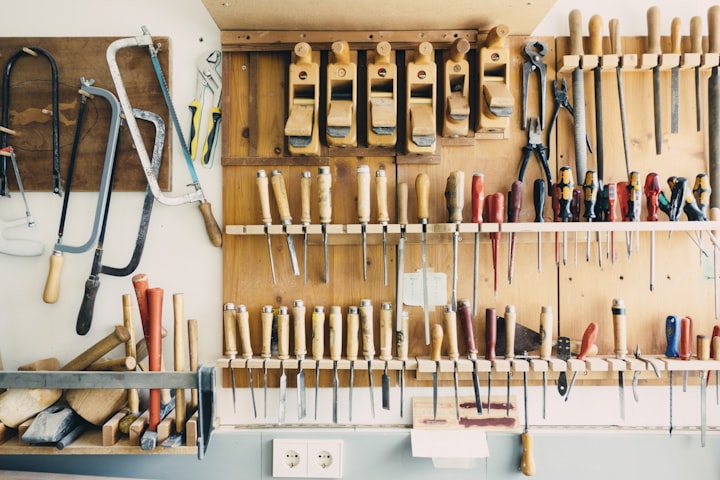Joinery: Handmade vs Machine Made
Ted's Tips on making Furniture

JOINERY: HANDMADE VS. MACHINE-MADE
Woodworking comes in all shapes, sizes and varieties. But no matter what your woodworking passion might be, eventually you’re going to need to join together two pieces of wood. And that opens up a world of joinery options.
Some prefer the classics like dovetails, lap joints, or mortise and tenon. Pocket-hole joinery is a hot option right now, and of course there’s the old tried-and-true biscuit or domino joinery to consider.
Whatever method you choose, the question is—do you make your joinery by hand or by machine? Here’s what our experts had to say…
THE OLD-FASHIONED WAY
Much can be said about the satisfaction of creating something by hand. Hand Tool Coach says the biggest difference between creating joinery using hand tools and using a machine to help is ownership. “To stand back at the end of the day and look at something you have made is priceless,” he said.
His Project classes introduce traditional hand tool woodworking to combat wounded veterans, and he loves seeing them light up with a sense of accomplishment after completing their first hand-cut dovetails. This “woodworking therapy,” as he calls it, is perfect for those who suffer from PTSD and a variety of negative physical and mental effects from their time in service. “There's no dust, no danger, no noise,” Rob said. And it can be done in a small space.
“For many, the dovetail is a rite of passage especially when talking about hand cut,” states Woodcraft Director of Product Development Echoing what sees with the vets in his class, “I find hand cut to be therapeutic.”
Ted said for him, it all comes down to how much time you have. “If I had all the time in the world to complete my projects (i.e. no deadlines), sitting down with some hand tools would be very relaxing to me.”

If you like these Tips visit Ted’s Today! bit.ly/woodworkingstepbysteptips
Still, He added, “I do occasionally like to test my skills and learn new joinery techniques with hand tools only, but those practice joints are just for fun and educational purposes.”
Ted adds that creating hand-cut joinery makes the completed piece more personal for the craftsman, as well as the recipient if it’s a gift.
Depending upon the woodworker’s skill level, a trained eye will notice the quality of the joint and have appreciation for it. This could also be a disadvantage if not executed properly.
Another possible downside is that hand-cut joinery can take longer to produce than with machines.
Hand tools for creating joinery might include: handsaw, bench chisels, wood mallet, 4" double square, marking knife, marking gauge, bevel gauge, low angle block plane, and #4 hand plane.
THE NEED FOR SPEED
One of the biggest advantages to machine joinery is the ease in achieving uniformity and repeatability from joint to joint.
Ted stated that production runs are faster to produce once the machines are set up, which is a great benefit if you are making several pieces of furniture (i.e. dining room chairs or cabinets).
However, woodworking machines traditionally come at a higher cost than hand tools. There is also the issue of space required for using and storing this equipment. In addition, there can be a considerable time investment in setting up the machinery.
A seasoned woodworker will be able to tell if something is machine made, making that a “con” to woodworking purists who may find that as a shortcut to traditional methods.
Often operating under time restraints, Ted explained, “When it comes to my actual builds, I happily take advantage of modern machinery. I’m so thankful for the power tools that help me build my projects quickly and efficiently.”
Ted notes that while some dovetail jigs are adjustable, most will confine you to a set spacing. Hand-cut dovetails do not have these same limitations.
Ted said that machine-cut joints give him satisfaction when they pop together, though they don’t provide the therapeutic benefit of hand-cut joinery, and there is the noise, the dust and the mess.
Woodworking machines and jigs that aid in creating joinery include: Festool Domino, LEIGH dovetail jigs and Kreg pocket-hole jigs.
If you like these Tips visit Ted’s Today! bit.ly/woodworkingstepbysteptips

HYBRID WOODWORKING
Both machine and hand-cut joints are incredibly strong. But is one better than the other?
Ted advises if you’re not building furniture for a living, take the time to create with your hands for the ultimate sense of satisfaction. “You’re not a machine operator, you’re a woodworker.”
Ted often makes the call depending on the project: “If I have a few joints to do on a special project, I will generally cut by hand. If there are several, a machine cut is the way to go.”
One way Ted uses the benefits of both hand-cut methods and machine-made processes is what he calls hybrid woodworking. “I use machines to speed things up, but when I want real precision, I use hand tools,” he said.
Tamar echoes the hybrid approach. “My power tools do the heavy lifting, and the hand tools come in to refine it all.”
Now that’s the best of both worlds!
Whichever method you choose, Ted’s has the advice to take your next project from start to finish!
If you like these Tips visit Ted’s Now! bit.ly/woodworkingstepbysteptips
About the Creator
stevee james
We do research in Health and Fitness, Products, Facts and give Tips so you can lose those extra Pound.






Comments
There are no comments for this story
Be the first to respond and start the conversation.